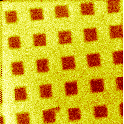TOF-SIMS

Time-of-flight secondary-ion mass spectrometry (TOF-SIMS) is a surface sensitive technique used to probe a material’s long-range chemical structure through the mass spectral analysis of desorbed molecules and molecular fragment ions.
The Facility houses an IONTOF TOF.SIMS 5 system. Several operational modes are available:
- static SIMS mode – very low incident ion doses are used to probe the molecular structure and long-range chemistry of surfaces; the low ion dose ensures that intrinsic surface chemistry, and not ion-induced chemistry, is being probed; static SIMS is highly complementary to XPS for monolayer and polymer surface analysis of organic materials, providing long-range chemical information.
- dynamic SIMS mode – high incident ion doses are used to sputter off surface layers and probe elemental composition as a function of depth into a sample; most molecular information is scrambled; quantitation and sensitivity can be as high as parts per billion in some cases; dynamic SIMS is useful for layered samples, inorganic materials and impurity analysis.
- imaging SIMS mode – a focused ion beam can be rastered over a surface to collect static SIMS spectra as a function of lateral position; resolution better than 100 nm can be achieved with very high mass resolution (m/Dm > 10,000). An example of such an image of a patterned surface is shown below, in which the protein fibronectin is present in the squares (CN- ion image), and a polyethylene oxide brush polymer is present between the squares (O- and CH3O+ ion images).
 |
 |
 |
| 154 × 154 µm2 |
154 × 154 µm2 |
154 × 154 µm2 |
|
O– ion image
|
CN– ion image
|
CH3O+ ion image
|


